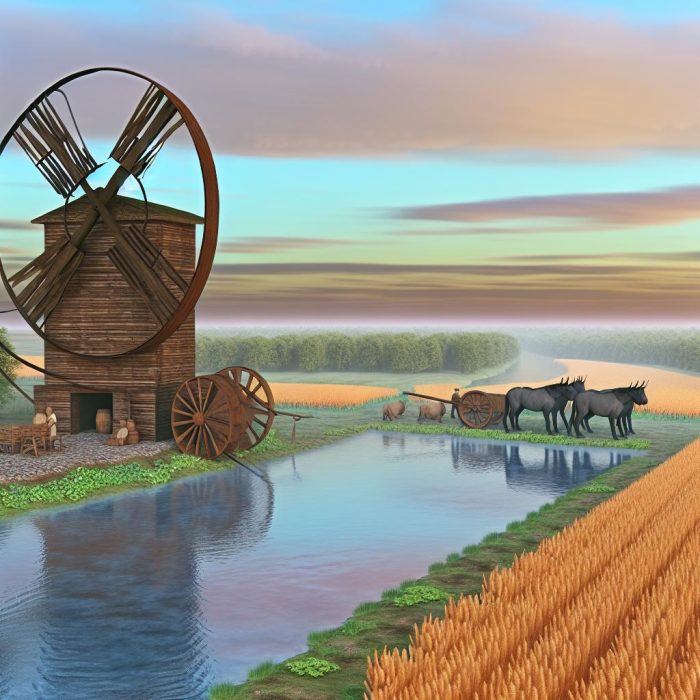The Role of Mills in the Roman Empire
During the time of the Roman Empire, mills had a pronounced impact on the economic and technological environment. These facilities were critical for processing various goods, thereby supporting the broad and intricate economy of the empire.
Types of Mills in the Roman Empire
In the Roman Empire, a variety of mills were developed, each catering to specific requirements. Among these, grain mills held a prominent position due to their essential function in transforming grain into flour. The trapetum was another significant type, mainly utilized for crushing olives and deriving oil.
Grain Mills
Central to sustaining one of Rome’s basic food items — bread, grain mills were indispensable. The commonly used structure for grinding grain was the rotary quern, which over time developed into the more advanced animal-powered mills. Typically, slaves or animals such as donkeys were employed to turn the substantial millstones. Progressively, more sophisticated watermills emerged, utilizing the power of moving water to grind grain more efficiently, setting the stage for significant advancements in productivity.
Olive Oil Production
The production of olive oil, a valuable commodity in ancient Rome, relied heavily on the trapetum. This contraption, consisting of a large stone basin and rollers, was instrumental in crushing olives to extract oil, a process crucial to one of Rome’s major exports. Olive oil was not solely reserved for culinary purposes and lamps at home; it was also a key trade item throughout the Roman Empire, contributing significantly to the economic prosperity of the region.
Innovation and Technological Integration
Roman mills were emblematic of innovation, involving the integration of earlier technologies from various civilizations. By adapting techniques from the Greeks and Egyptians, the Romans advanced their milling processes. This included the integration of water-powered mills, which significantly reduced reliance on labor-intensive human and animal energy.
Watermills
The introduction and widespread use of water-driven mills marked a pivotal advancement in milling technology. These mills harnessed the energy from flowing bodies of water, greatly enhancing productivity. A prime example of Roman innovation and effective urban planning is the Barbegal complex in France, which comprised an extensive series of watermills. This complex demonstrated the Romans’ ability to maximize both productivity and urban efficiency through technological advancements.
Economic Impact
Mills played a key role in shaping the Roman economy, influencing economic activities in both urban and rural settings. Their availability facilitated the growth of markets and supported expanding city populations by ensuring a reliable supply of processed goods, particularly flour and oil. The advent of mechanized milling processes was instrumental in freeing up a considerable portion of the workforce, which could then be redirected towards other areas of economic activity, thereby enhancing the overall economic dynamism of the Roman Empire.
Urban Economic Activities
In the bustling urban centers of the Roman Empire, mills contributed significantly to economic activity. By transforming raw agricultural products into more refined goods, these facilities supported vibrant marketplaces and helped meet the demands of growing urban populations. The mills’ role in centralizing production and distribution processes enhanced the efficiency of trade and commerce, fostering economic growth and stability across the empire.
Rural Economic Activities
In rural areas, the presence of mills encouraged agricultural production by providing local farmers with the means to process their crops efficiently. This not only increased the productivity of rural communities but also strengthened their economic ties with urban centers. The exchange of goods facilitated by the operation of mills contributed to a more interconnected and stable regional economy, providing rural communities with access to broader markets and fostering economic integration throughout the empire.
Conclusion
In conclusion, mills were fundamental to Roman technological achievements and economic infrastructure. Through continuous innovation, the Romans greatly enhanced their production capabilities, paving the way for a more dynamic and prosperous empire. While the specific technologies have evolved over time, the foundational milling techniques established by the Romans have continued to influence milling processes for centuries, highlighting their enduring contribution to technological history. The legacy of Roman mills is evident not only in the ancient artifacts and ruins that survive but also in the ongoing advancements in milling technology that continue to shape our modern world.



